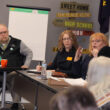Data from this year’s Point in Time (PIT) Count revealed 1,502 individuals are experiencing homelessness across the tri-county region of Linn, Benton and Lincoln counties, a modest increase from last year’s total.
Those figures come from the Community Services Consortium (CSC) of Linn, Benton, and Lincoln Counties, which coordinated this year’s PIT Count in January, capturing data on sheltered and unsheltered individuals and families across the region.
The PIT Count is a federally mandated initiative by the U.S. Department of Housing & Urban Development (HUD), requiring counties nationwide to manually count individuals experiencing homelessness on a single day. While the count is never exact – especially in rural areas like Linn, Benton, and Lincoln Counties – it remains a vital tool for guiding housing development, shelter funding, outreach efforts, and long-term planning.
Notably, Linn and Benton Counties reported more sheltered individuals than unsheltered, a reversal from previous years. This shift is attributed to increased state investments in shelter funding and the presence of cold weather sheltering operations in Linn and Benton County during the January count, which temporarily brought more people indoors just in time.
County Highlights
Linn County
- Total homeless count: 454
- Sheltered: 240 | Unsheltered: 214
- Homeless youth (0–24 years old): 88 (19.4%)
- Domestic violence survivors: 41 (9%)
- Chronically homeless: 178 (39.2%)
- Serious mental illness and/or substance use disorder: 105 (23.1%)
- Veterans: 27 (5.9%)
- People who identify as Black, Indigenous, Hispanic, or other Person of Color: 83, or 18% of the unhoused population, which generally reflects the total county population ratio
- Men continue to experience homelessness at significantly higher rates than women, representing 61.7% of the unhoused population in Linn County
Benton County
- Total homeless count: 550
- Sheltered: 289 | Unsheltered: 261
- Homeless youth (0–24 years old): 92 (16.7%)
- Domestic violence survivors: 82 (14.9%)
- Chronically homeless: 151 (27.5%)
- Serious mental illness and/or substance use disorder: 148 (26.9%)
- Veterans: 17 (3%)
- People who identify as Black, Indigenous, Hispanic, or other Person of Color: 129, or 23% of the unhoused population, which generally reflects the total county population ratio
- Men continue to experience homelessness at significantly higher rates than women, representing nearly 60% of the unhoused population in Benton County
Lincoln County
- Total homeless count: 498
- Sheltered: 247 | Unsheltered: 251
- Homeless youth (0–24 years old): 149 (29.9%)
- Youth count surge: The rate of unhoused youth has more than doubled since the 2024 count. This is due to Lincoln County School District and McKinney Vento making a concerted effort to ensure a comprehensive count of unhoused youth, to prioritize getting the resources needed to address the local youth housing crisis.
- Domestic violence survivors: 33 (6.6%)
- Chronically homeless: 101 (20.3%)
- Serious mental illness and/or substance use disorder: 96 (19.3%)
- Veterans: 14 (2.8%)
- People who identify as Black, Indigenous, Hispanic, or other Person of Color: 136, or 27.3% of the unhoused population, which is overrepresented in comparison to the total county population ratio by about 8%
- Different from Linn and Benton Counties, there is a near even split between men and women experiencing homelessness in Lincoln County
Across all three counties, the highest represented populations include youth, defined as 0-24 year olds; chronically homeless, defined as someone with a disability who has been homeless for at least 12 months, or has experienced at least four episodes of homelessness within the past three years; individuals with serious mental illness and/or substance use disorder; and, generally the disparity of men experiencing homelessness.
The above areas have had a disproportionately high increase since 2024, compared to the minimal increase in overall homelessness. According to a CSC statement, investments made by the state of Oregon in funding to quickly identify and rehouse those living on the streets, known as rapid rehousing, made an impact, particularly on those who were able to work and maintain their housing. Without which, these counts would have likely been higher. Also, the CSC said, the emerging needs are much more complex and nuanced, which require far more collaborative, innovative, and larger scale response to address.
“We’ve seen firsthand how much impact local investments in the PIT count have on the accuracy and outcome of the results,” said Dina Eldridge, housing senior operations manager for CSC. “The data from these counts truly can, and has, represented millions of state and federal housing dollars that can make or break initiatives within local communities.”
“It remains imperative that we obtain comprehensive counts for every corner of our region, which requires investment from our community members and partners, as well as the cities and counties,” Eldridge continues, “In order to get the outputs we desperately need, we need the right input. And the PIT count is the place to start”
For more information or to get involved in next year’s count, contact [email protected].





